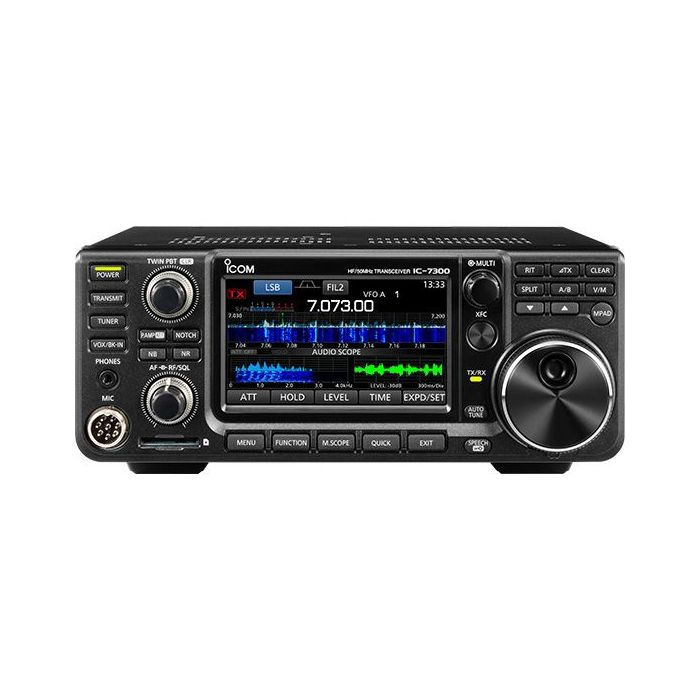Output power: 100W (25W AM))
RX Frequencies: 0.030-74.800
Receiver type: Direct sampling
RF direct sampling system
The IC-7300 employs an RF direct sampling system, where RF signals are directly convert to digital data. Then processed in the FPGA (Field-Programmable Gate Array), making it possible to simplify the circuit construction as well as reduce noise that can mask weak signals.
The new “IP+” improves the 3rd order intercept point (IP3) performance improving the ability to copy a weak signal that is adjacent to either a strong interfering signal. In this process, A/D converter is optimized to reduce or eliminate signal distortion.
RMDR and phase noise characteristics
The IC-7300’s RMDR is about 97dB* (typical value) improving the Phase Noise characteristics by about 15dB (at 1 kHz frequency separation). The superior Phase Noise characteristics reduce noise components for both receive and transmit signals.
* At 1 kHz frequency separation (received frequency: 14.2MHz, MODE: CW, IF BW: 500Hz)
15 discrete band-pass filters
The RF Direct Sampling is protected by an array of bandpass filters. The signal passes through one of the fifteen bandpass filters, where signals outside the passband are rejected. To reduce the insertion loss, the IC-7300 utilizes High Q factor coils.
Large color touch screen
The large 4.3” color TFT touch LCD offers intuitive operation of functions, settings, and various operational visual aids such as the band scope, waterfall function, and audio scope.
Like on the high-end rigs, the waterfall shows a change of signal strength over a period of time and allows you to find weak signals that may not be apparent on the spectrum scope.
Use the audio scope function to observe various AF TX/RX characteristics such as microphone compressor level, filter width, notch filter width and keying waveform in the CW mode. Image below shows the Audio scope with the waterfall function and the oscilloscope.
Real-Time spectrum scope
You no longer have to choose whether to listen to the audio or have the spectrum scope sweep for signals as the IC-7300’s real-time spectrum scope offers the simultaneous operations found in some of the more expensive rigs! This means you can use either the spectrum scope or the waterfall to quickly move to an intended signal while listening to the receiver audio. The ‘7300’s touch screen introduces a “Magnify” function. So, when you first touch the scope screen around the intended signal, the touched part is magnified. A second touch of the scope screen changes the operating frequency and allows you to accurately tune.
- Built-in automatic antenna tuner
- 101 channels (99 regular, 2 scan edges)
- SD memory card slot for saving data
- Cooling fan system
- Multi-function meter
- CW functions: full break-in, CW reverse, CW auto tuning
- SSB, CW, RTTY, AM, FM modes
- IC-7300
- Hand Microphone - HM-219
- DC Power Cable
- Fuses
- Plugs
Icom America will no longer be including CD Manuals in the box for certain
mainframes. Users can still access and download the manuals on Icom
Japan’s website at the following web address:
https://www.icomjapan.com/support/manual/
Below is the list of radios and CD manual removal dates:
- IC-7610 as of June 2020
- IC-7851 as of June 2020
- IC-7300: as of July 2020
- IC-7100: as of July 2020
- ID-5100: as of August 2020
How do I update the firmware? This is a very common question. The process involves downloading the firmware file from Icom's website, copying it to an SD card, and then performing the update on the radio itself through the menu system.
Where do i download the latest firmware? You can get the latest firmware for the Icom IC-7300 by visiting Icom's website HERE.
What is "GENE" on the touchscreen? This button appears when you tap the frequency display. "GENE" is short for "General Coverage," allowing you to access frequencies outside of the standard amateur radio bands.
What does "OVF" mean? "OVF" stands for "Overflow." It indicates that the receiver is being overloaded by a very strong signal. The solution is to reduce the RF gain until the "OVF" indicator disappears.
How does the real-time clock work, and why does it lose time? The IC-7300 has a real-time clock that is backed up by an internal battery. A common issue, especially in older units, is that this battery loses its charge, causing the clock to reset every time the radio is powered down. The official solution is to keep the power supply on for about a week to fully charge the internal capacitor and battery.
Is RF getting into my radio/USB cable? The IC-7300's sensitivity to RF interference on its USB line is a known concern. Many users find that using a high-quality USB cable with ferrite chokes is essential to prevent strange behavior or resets.
My receiver seems deaf or overloaded by strong signals. This can be a symptom of a few things. First, as mentioned previously, the "OVF" indicator shows an overload. The solution is to reduce the RF Gain. Second, the radio's performance can be degraded by strong local broadcast stations or nearby ham stations, which can cause the receiver to become desensitized.
How do I save and load my settings? The IC-7300 has an SD card slot, which is a key feature for backing up and restoring radio settings.






